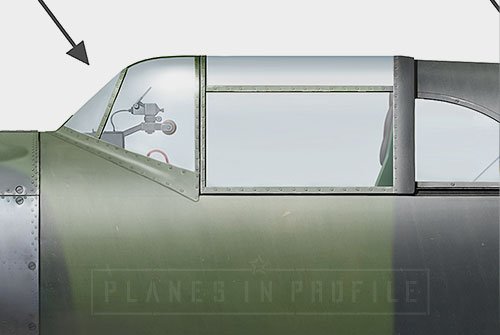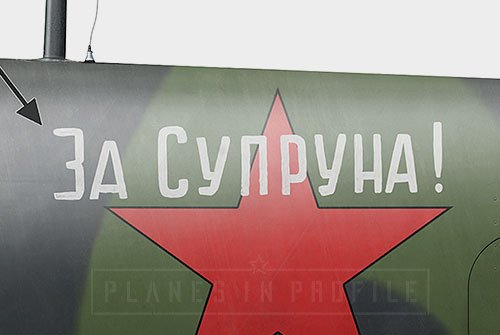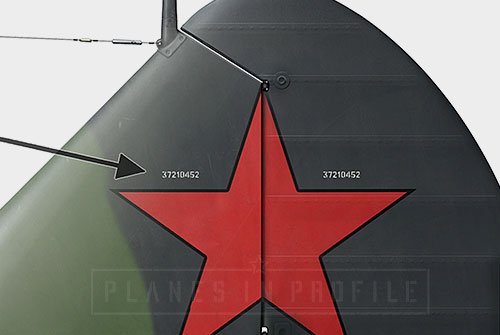Senin’s White-52, “Za Supruna!”
LAVOCHKIN, LA-5 (TYPE 37)(Early)
263-rd IAP, 215-th IAD, 2-nd IAK, 14-th Air Army, Volhovskiy Front, circa February 1943, Leningrad region.
Flown by junior lieutenant Daniil Ilyich Senin.
A few days after the start of the bloody war between Germany and USSR, on the 26th of June 1941 Lieutenant Colonel Stepan Pavlovich Suprun formed a ‘Special Purpose Fighter Aviation Regiment’ (IAP ON) consisting of experienced test pilots from the Research Institute of the Soviet Air Forces. The regiment was called 401st IAP ON, and Suprun became its first commander. Just over a week later, on the 4th of July, while attempting to stop the onslaught of the invading enemy forces in his MiG-3, Suprun died defending his motherland.
The next month, on the 16th of August 1941, 401st IAP ON was reorganised into the 263rd IAP. [2]
263rd IAP received their La-5 airplanes in late 1942 and trained to operate them from 04.08.1942 - 18.10.1942 in 4th ZIAP, PriVO (ПриВО) in Morshansk. These machines were a mix of airplanes of various series between series 02 - 06 [3], with White-52 being a series 04 plane.
From November 1st 1942 the regiment rejoined the active army, this time armed with their new La-5 airplanes. For Junior Lieutenant Senin, Autumn of 1942 was when he got a taste of real battle for the first time.
From November 24, 1942 to January 20, 1943 the regiment took part in the Velikiye Luki offensive operation as part of the 3rd Air Army, supporting the 3rd Shock Army of the Kalinin Front which aimed to pin down German troops in the central section of the front and to liberate the cities of Velikiye Luki and Novosokolniki. [4]
From January 12, 1943 to January 30, 1943, as part of the 14th Air Army[5], the regiment participated in the Soviet offensive operation codenamed ‘Iskra’ (Spark) aimed at Breaking the blockade of Leningrad [4]. It was while taking part in this operation that young Daniil scored his first victory , though it was a shared one:
1) 14.01.43 1 Ме-109 (shared victory)
Five days later, which was one day after the Soviets broke through the blockade of Leningrad, Senin scored his second victory by downing a Ju-88 bomber
2) 19.01.43 1 Ju-88
The heated air battles continued after ‘Operation Iskra’ and became especially intense for 263rd IAP during Krasnoborskaya and Smerdynskaya operations in February. During this time the Soviets attempted to break through enemy defences, surround and destroy a part of Germany’s 18th army. In two weeks from about the 10th to the 23rd of February the pilots of the 14th Air Army flew 2,310 day-time battle sorties 830 night-time sorties. 263rd regiment flew 233 of these sorties.
Combined with statistics from the time of ‘Operation Iskra’ between Jan 12th-31st and the following operations between Feb 10th-23rd, the pilots of 263rd IAP flew 260 and 233 battle sorties (483 in total) and Its pilots scored 14 and 15 victories (29 in total). But the losses were heavy on the Soviet side, 14th IAK lost 43 Il-2 and 17 Pe-2, as well as 26 fighters (86 airplanes in total). For 263rd IAP in particular, the losses amounted to 12 and 8 La-5s (20 in total). By 23rd of February only 10 serviceable La-5s with their crew remained in 263rd IAP. In other words, in just over a month, 263rd IAP lost the majority of its planes and pilots. Due to the high losses sustained by the Red Army, the air operations in the area were suspended on the 23rd of February and four days later operations on the ground were suspended also. [6]
Tragically, on that fateful day of the 23rd of February just as the air operations were about to be suspended, one particular battle sortie came at a very high cost to the 263rd IAP. It’s a sortie that claimed the life of one of the most famous Soviet Aces of the pre-war period, an Ace with no less than 15 air victories(personal+shared) over the Japanese, commander of the 215th IAD, two times Hero of the Soviet Union, Lieutenant General Grigory Panteleevich Kravchenko. In that sortie, four pairs of La-5s consisting of Kravchenko-Kuznetsov[7], Pitolin-Smirnov, Alifanov-Senin, Rakitin-Sapegin came across 15 enemy airplanes in the region above the towns of Sinyavino and Mga at around 1 oclock in the afternoon. The enemy consisted of 3 Me-110 spotters and their escort of 6-8 FW-190 and 2 Me-109 fighters. These were later joined by one more pair of fighters, led by none other than the commander of group ‘1’ of the infamous JG-54 (Grunhertz), Major Hans Philipp, an Ace with about 170 victories. The Soviets were also joined by another pair of La-5s.
Alifanov’s pair drew first blood when Alifanov and his wingman Daniil Senin rushed at the Me-110s. Alifanov downed the first spotter and Senin downed the second with four bursts from his cannons. This was Senin’s third air victory
3) 23.02.43 1 Ме-110
While attacking, the Soviet pairs broke up and a series of smaller air battles ensued in which the Soviets downed 2 FW-190s. But these came at a great cost, because by the end of this sortie, the losses on the Soviet side consisted of Lieutenant General Kravchenko, Major Kuznetsov and Senior Lieutenant Smirnov. Major Alifanov and Junior Lieutenant Pitolin both sustained damage to their Lavochkins but managed to belly land them (Pitolin landing his plane on one wheel). Both latter pilots survived the sortie with light wounds. [8]
A good description and detailed analysis of this battle can be found in an awesome article called ‘Bloody '“Spark” of General Kravchenko’ written by Mikhail Timin on Warspot.ru
Daniil Senin was the lucky pilots who came back from this battle sortie unscathed and even with a victory. A few weeks later Senin scored two more victories:
4) 16.03.43 1 FW-190
5) 17.03.43 1 FW-190
Daniil’s luck ran out on the 4th of July 1943 when he was shot down during an air battle. He was about 22 years old.
Noteworthy Visual Characteristics
General) The airplane seems to be relatively ‘un-aged’ in the photo reference. Being a ‘series 04’ airplane it was probably built in September 1942 and was already a few months old in Winter 1942-43 (the time when the photo is presumed to have been taken). It was most probably painted in accordance with the standard Green/Black camo pattern, with the stars in the usual 6 positions. Being an early series La-5 it features some of the characteristics of these early machines, as described below.
1) Note the design of the windshield - it’s that of the LaGG-3, typical to the early La-5s. Only the first few series of the La-5s (Probably up to ‘series 06’) numbering about 200 planes, were produced with these ‘rounded’ LaGG-3 style windshields.
2) The inscription says ‘За Супруна’ (Za Supruna) translates to ‘For Suprun’. It’s a message of vengeance for the death of the Deputy of the Supreme Soviet of the USSR, two times Hero of the Soviet Union (his second was awarded posthumously) , Lieutenant Colonel Stepan Pavlovich Suprun.
Stepan Suprun was the original founder and commander of the regiment which became 263rd IAP. Before that he was a Soviet test Pilot and a fighter pilot who fought against the Japanese in China in 1939-40.
3) The serial number of White-52 was apparently 37210452 [1]. ‘37’ is the type of La-5, ‘21’ is the number of the factory where it was built, ‘04’ is the series number, 52 is the number of the airplane in the production line, also used as the airplane’s tactical number.
4) Note the ‘flat’ tailwheel doors. ‘Series 04’ is when this simpler, more streamlined style of doors, was implemented into the La-5 design. Previously to this the doors were ‘bulged’.
5) No photo reference was available to confirm the tactical number, however, based on the serial number (presuming that it’s correct) we can be pretty confident that it was ‘52’.
6) The warning on the wheel shields might have read ‘Не Вставать’ which loosely translates to ‘Don’t get up (on top of) ’. This seems to have been more common to the early La-5 planes than the other variation of this warning which is ‘Не Становиться’ (loosely translates to ‘Don’t stand on’ ) which was more common to the later La-5 modifications.
7) Note the presence of extra fuel tanks on the wings, marked by ‘7a’ and ‘7b’. Up until ‘series 08’ all La-5s were built with 5 fuel tanks, from ‘series 09’ onwards the number of tanks was reduced down to 3.
8) Note the presence of a ‘trimmer’ on the left aileron, a leftover from the LaGG-3 design. The trimmer was removed on the later series of La-5 airplanes, starting with ‘series 09’.
Here are a few close-up images to help illustrate the points above. Full set of close-up images is On Patreon
Footnotes
[1] Serial number was taken from an article by Mikhail Timin called ‘Bloody “Spark” of General Kravchenko’ , published on warspot.ru
[2] The information in the first two paragraphs is based on the Wikipedia article about 263rd IAP and a Wikipedia article about Stepan Suprun.
[3] Based on the information on http://ava.org.ru/iap/263.htm
[4] Taken from the Wikipedia article about 263rd IAP
[5] The regiment became part of the 14th Air Army Jan 1st 1943
[6] These two paragraphs are based on the information in the article by Mikhail Timin called ‘Bloody “Spark” of General Kravchenko’ , published on warspot.ru
[7] It’s worth noting that Victor Ivanovich Kuznetsov, who was General Kravchenko’s wingman in the above mentioned sortie, was the only surviving pilot from the original personnel of the 401st IAP OsNaz by that time.
[8] The info about the battle is based on the combat report of the headquarters of the 263rd IAP for February 23, 1943. The description of the report is included in the article by Mikhail Timin mentioned in point [3] above.
Summary of LINKS TO THE REFERENCE IMAGES AND VIDEOS
Image 1
All the work presented on this is page is subject to updates and revisions in the light of new information which might present itself. If you have any new information relevant to this page or disagree with anything that's presented here, then please feel free to contact me through the Planes in Profile Facebook page.
Thanks lots for visiting this page!:)





